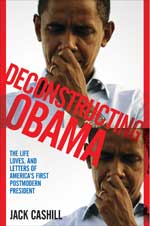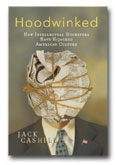DOJ to Ferguson:
Adopt Strategy That Killed Trayvon
Get your copy of Jack Cashill's latest book, "You Lie!"

___
Get your copy of Deconstructing Obama

___
Jack Cashill's book:
Hoodwinked: How Intellectual Hucksters have Hijacked American Culture
© Jack Cashill
AmericanThinker.com - March 9, 2015
There are many flaws with the Department of Justice’s report on policing in Ferguson, Missouri. The most glaring is the report’s use of statistics, but the most egregious, as shall be seen, is the strategy the DOJ recommends to address statistical disparities.
Says the report: “From 2012 to 2014, 85% of people subject to vehicle stops by Ferguson police were African-American; 90% of those who received citations were black; and 93% of people arrested were black. This while 67% of the Ferguson population is black.”
The population of Ferguson was 67 percent black in 2010. If the numbers continued to trend as they had from 2000 to 2010, the city would have been about 73 percent black when Michael Brown was shot in 2014, but that is not the real issue.
In transitional areas like Ferguson, younger white people with children are the first to move. Older families tend to hang on. It is altogether likely that the black percentage in the high-crime cohort of young men aged fifteen to twenty-nine would have been 80 percent or more.
According to the Center on Juvenile and Criminal Justice, black youths nationwide—who make up roughly 13 percent of their age group population--account for 26 percent of juvenile arrests, 44 percent of youth who are detained, 46 percent of the youth who are judicially waived to criminal court, and 58 percent of the youth admitted to state prisons. The Ferguson numbers are well within the national norm.
Only one set of crime statistics is kept well enough to rule out the role bias might play in arrest rates, and that is for homicide. According to the US Department of Justice, blacks accounted for 52.5 percent of homicide offenders from 1980 to 2008, at least four times more than what one would expect were all racial groups committing crime at the same rates.
As often as not, a person’s proclivity towards crime manifests itself when the person is still in school. According to a Justice Department study, black students were more than twice as likely to be suspended from school, expelled or arrested than students of other races.
The DOJ report excoriates the Ferguson Police Department for resorting to arrest when called into the schools to quell disturbances. That mindset, says the DOJ, shows “insufficient appreciation for the negative educational and long-term outcomes that can result from treating disciplinary concerns as crimes.”
As evidence of those outcomes, the report cites information in the DOJ’s Orwellian 2014 “Dear Colleague Letter.” This letter was a follow up to a July 2012 executive order warning school districts to avoid “methods that result in disparate use of disciplinary tools.” The White House headlined the press release announcing this dubious stroke of reverse racism, “ President Obama Signs New Initiative to Improve Educational Outcomes for African Americans.”
One model school district in the eyes of the DOJ was the Miami-Dade County Public Schools, one of the few districts with its own police department. The late Trayvon Martin had the seeming good fortune of pursuing his education therein.
Appearances deceive. The Miami-Dade Schools Police Department (M-DSPD) had problems unique to its peculiar mission. The exposure of the department’s practices began inadvertently with the Miami Herald story on Martin’s multiple suspensions. The article prompted M-DSPD Chief Charles Hurley to launch a major Internal Affairs (IA) investigation into the possible leak of this information to the Herald.
As the investigation began, the officers realized immediately that they had a problem on their hands. “Oh, God, oh, my God, oh, God,” one major reportedly said when first looking at Martin’s data.
He could see that Martin had been suspended twice already that school year for offenses that should have gotten him arrested. In each case, however, the case file on Martin was fudged to make the crime less serious than it was.
To their credit, the officers, when questioned, told the truth about Martin and about the policies that kept him out of the justice system. From their statements, made under oath, it appears that Hurley instructed his officers to divert offending juveniles away from the criminal justice system and back to their respective schools for discipline.
Hurley did this subtly. As one detective told IA, the arrest statistics coming out of Martin’s school, Dr. Michael M. Krop Senior High School, had been “quite high,” and the detectives “needed to find some way to lower the stats.” This directive allegedly came from Hurley.
At least a few officers confirmed that Hurley was particularly concerned with the arrest rates of black males. In a letter obtained by NBC 6 of South Florida, a senior detective wrote, "[Hurley] asked that I reduce the number of arrests I affect of all black juveniles. I told him regardless of the race of an individual; if probable cause existed for an arrest that individual would be arrested. He was not happy with my response to his request."
“Chief Hurley, for the past year, has been telling his command staff to lower the arrest rates,” volunteered another high-ranking detective. When asked by IA whether the M-DSPD was avoiding making arrests, that detective replied, “What Chief Hurley said on the record is that he commends the officer for using his discretion. What Chief Hurley really meant is that he’s commended the officer for falsifying a police report.”
The IA interrogators seemed stunned by what they were hearing. They asked one female detective incredulously if she were actually ordered to “falsify reports.” She answered, “Pretty much, yes.”
In a purely statistical sense, Hurley’s policies were working. On Feb. 15, 2012, eleven days before Martin’s death, the Miami-Dade County Public Schools put out a press release boasting of a 60 percent decline in school-based arrests, the largest decline by far in the state.
“While our work is not completed, we are making tremendous progress in moving toward a pure prevention model,” Hurley told the Tampa Bay Times, “with enforcement as a last resort and an emphasis on education.”
In truth, however, the only “education” a diverted student like Martin was getting was to be sent home—or wherever—on an unmonitored suspension. As a result, his parents seemed genuinely oblivious of the kind of trouble he had been getting into. Nor was there any “prevention.” With their previous crimes winked at, students felt empowered to commit more.
Beyond the fighting and the drugs, Martin’s apprehension with stolen women’s jewelry and a burglary tool should have been a wake-up call for everyone in his life. It was not. Given the directives from the top, the officer involved in the case chose not to link Martin directly to the jewelry.
The officer did not do this of his own initiative. He told his sergeant, as the sergeant later testified under oath, that “they needed to cut back on any type of crime that was going on [at Michael Krop], and that it came up from his supervisor up the chain.” There was no further investigation.
As far as Martin’s parents knew, Martin had wandered into an “unauthorized area” and been suspended. No big deal. Boys will be boys. George Zimmerman learned otherwise. The Trayvon Martin he met was angry, high, violent and looking for trouble.
Within a year of Martin’s death, Hurley would be demoted and then forced out of the department. He was the fall guy. The following year, his superintendent, Alberto M. Carvalho, was awarded the FBI Director’s Community Leadership Award “in recognition of his work enhancing students’ academic enrichment.”
On Father’s Day 2008, candidate Obama had given a rousing speech at a black church in Chicago. He traced racially disparate crime outcomes to their real source, telling the congregants that boys who grow up in fatherless homes were “twenty times more likely to end up in prison.”
The left would hear none of it. Said Jesse Jackson on a hot mic, "I want to cut his nuts out. Barack, he is talking down to black people." Safer, Obama realized, to write reports, hand out awards, and watch young black men die every year by the thousands.


